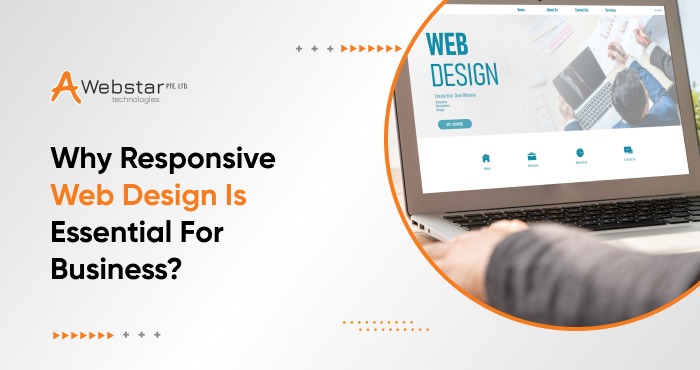
A responsive website has become a necessity for success in the present business scenario. In case your business does not possess one such website chances are you may lag behind your competitors. The benefit of a responsive web design is that it sets your brand at the forefront and offers an excellent user experience. Ultimately, you will be able to attract visitors and retain them for longer which will boost your conversions, sales and hence revenue.
A majority of people currently access the internet through smartphones, tablets and other mobile devices so it becomes essential to meet their needs. Only a responsive design can ensure that your website adapts to different screen sizes and resolutions. Thus, this makes it easy for users to navigate and consume content on any device. Additionally, it can also help you improve your rankings in search engines.
However, this can become a tedious task for firms who do not know the significance of a responsive web design. But worry not! This blog post will focus entirely on the need for Responsive Web Design for your business.
So, come along as we explore this topic in depth in the following sections. Let us begin!!
Elements of Responsive Design
This section of the blog post will focus on the elements of responsive design in detail. So, stay tuned and read till the very end.
Fluid Grid Layouts
These grid layouts allow web content to modify itself to various screen sizes and orientations. Plus, they confirm that the elements on a web page maintain proportion and readability. Moreover, it is regardless of the device on which it is being viewed. Furthermore, this flexibility enhances the user experience by providing a consistent and visually stunning layout across different platforms.
Flexible Images and Media
In order to increase the visual appeal and functionality of a responsive website the images and media are designed and scaled in a certain way. As a result, they appear fresh and properly positioned adapting to fit to different screen sizes and resolutions.
CSS Media Queries
These features usually permit websites to apply styles and layouts depending on the characteristics of the user’s device. This means that web pages can intelligently adapt their presentation ensuring readability and usability, on devices ranging from small smartphones to large desktop monitors. As a result, CSS media queries empower designers to create a user experience across a range of devices that are currently available.
User-Friendly Touchscreen Navigation
This includes creating navigation menus and elements that are user-friendly and specifically designed for devices. Afterwards, it ensures that users can easily explore a website access its content and utilize features through touch gestures like tapping or swiping. Consequently, smooth navigation minimizes frustration and motivates users to interact efficiently with the website.
Building a Responsive Website
It is important to take a view at how to build a responsive website. Hence, this entire section will make you familiar with the same. So, let us begin with it below.
Selecting the Right Framework
The framework you choose will ultimately determine the foundation of your site’s responsiveness. Your choice should align with your project’s specific needs as different frameworks offer various features and tools for responsive design.
Selecting the correct one will ensure a solid starting point for creating a website adjusting to diverse screen sizes. Thus, it provides an optimal user experience.
Mobile-Responsive Testing
This process generally involves thoroughly evaluating how your site performs and appears on various mobile devices. It ensures that it functions properly across different screen sizes, operating systems and browsers. You can identify and rectify any layout issues and navigation challenges that can withstand the user experience on smartphones and tablets. It further enhances accessibility and user satisfaction as a whole.
Iterative Development Process
This process involves an ongoing cycle of designing, testing and refining your site to ensure its responsiveness. Based on user feedback, device compatibility and changing design trends you can make gradual improvements. This approach allows for constant adaptation and optimisation that ensures your website remains up-to-date, user friendly and adaptable to evolving technologies and user needs.
Common Responsive Design Mistakes to Avoid
This part of the blog post will shed some light on the common responsive design mistakes that you must avoid to retain your clients. Come, let’s take a look at it below together!!
Ignoring Performance Optimisation
If you fail to prioritise performance it can result in slow page loading times. This can further lead to frustrating users and eventually result in higher bounce rates. It can ultimately lead to a considerable decrease in your client list. Hence, it becomes essential to optimise pages from time to time, minimise HTTP requests and leverage techniques like lazy loading and content compression.
Neglecting Content Prioritisation
When content optimisation is not given proper emphasis it can lead to cluttered and overwhelming layouts, especially on smaller screens. Designers must carefully assess which content is most appropriate for users. This ensures that it receives prominence in the responsive layout. To maintain a clean and organised design so that users can easily access essential information content must be at the top priority.
Not Testing Across Devices
You risk overlooking issues that may affect user experience and functionality if you skip conducting thorough testing on a range of devices. This testing ensures that your responsive design performs consistently and smoothly across all devices and platforms. It would ultimately ensure a smooth user journey. Overall, testing is an essential step to guarantee that your website is accessible and user-friendly to all visitors across any device.
Conclusion
Wrapping up, a responsive website is a strong foundation for any business that wants to grow its business in this digital world to new dimensions. The enhanced user interface and experience it extends are critically important in attracting and retaining customers. This blog post will prove to be a stepping stone as it describes various elements of building a responsive website and the common mistakes to be avoided.
Investing in Awebstar’s web design and development services allows you to harness its full potential. It would ensure that your business stays at the forefront of the online marketplace. Therefore, embrace the power of responsive web design today. Hence, witness the transformative impact it can emphasise on your business’s growth and success in the long run.















































